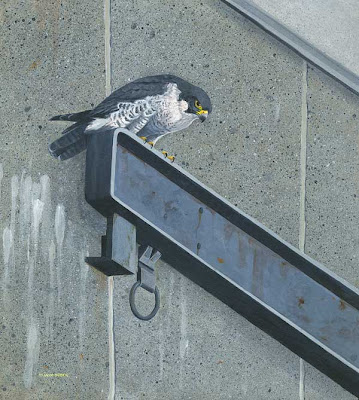
Mists before dawn promised a clear day, a window in the relentless procession of grey, wet and windy days that seem to have characterised this early 'summer'. On the way to the reserve I looked out over the mudflats to where the rising sun had set the sky to glowing with metalic pinks and peaches and had lit up the smoke from the distant power station with delicate shades of lilac. Yes this promised to be a sweet summer day.
In front of the car a green woodpecker took flight from the ground and banked away over a field filled with ragwort, the green and gold of the bird matching perfectly the green and gold of the flowers. Further on I spotted shapes moving in the mist soaked grass of an old orchard. Rabbits were quietly feeding alongside two juvenile green woodpeckers. It's easy to identify the juveniles of this species because, much like our own youth, they are covered in spots! One of the youngsters flew off into the trees but the other remained and went back to feeding. It kept a wary eye on me, stooping to feed then raising its head in a strangely snakelike way to peer over the grass at me.
Off to the side of the road at one point is an alien looking landscape, like something imagined by a science fiction writer as the surface of a distant planet, there is a field filled with hundreds of strange mounds, wound about with tendrils of mist. These are known as 'Emmett humps'. They are the work of colonies of yellow meadow ants over years, 'Emmett' being an old word for ant.

Despite the rising sun the Swale retained a thick blanket of low lying mist, the result of a hot and humid night of unsettled sleep. I stopped on the road at the entrance to the reserve to give the sun the time to warm the ground a little and allow the moisture to rise away and return to the sky, before I continued on to the farmhouse and the access track. The farm buildings were dripping with water and a surfeit of starlings. These noisy scoundrels filled every available edge and ledge. Those that survive will go on to make up some of the numbers of the enormous flocks of Autumn that are such a magnet for predators like the Merlin and the Peregrine.
At the apex of one barn though there were no starlings. This was due to the presence of a family of kestrels that have bred in the barn's roof rafters this year. The youngsters are on the very edge of fledging now but still can't quite tear themselves away from the familiar safety and security of their birthplace.

When the mist cleared and the sun was still low in the sky it created a glorious effect of light through the seed heads of the grass. They lit up against the green and waved gently like a vast hoard of people bearing golden flamed torches.

When I reached the car park I saw the unmistakable form of a barn owl hunting out over the grazing marsh. I positioned myself where I could see the nest box and at the entrance were two, well grown youngsters who, like the kestrels, were not far from fledging. I watched over the course of an hour or so and during that time the adults brought in four prey items, field voles from the look of them. The youngsters though didn't seem overly interested in the meals. This is good news, it means that they are well fed and the frequency with which the adults were returning with prey backs this up.








Watching the barn owls coming in with bundles of protein clutched in their eager talons it's easy to view the story from just one perspective; The new life of the owletts is sustained by the numbers of prey and the parent birds' hunting abilities. But there is a flip side to this, the voles' lives are abruptly ended to provide food for the growing birds. There is no moralistic slant to this, it is simply the way it is; Life for some comes at the price of death for others.
I was reminded of just how swift and close death on the marsh can be whilst watching a moorhen leading her brood of three chicks around the water's edge. They were quite endearing little creatures, comical almost, nothing much more than blobs of black fluff propelled on impossibly thin legs and ridiculously large feet. They were pootling around, pecking at everything, beginning to learn what is edible and what is not, when, without warning, a lesser black backed gull swept down and snatched one of them. The gull grabbed the chick by the head and its powerful beak crushed the skull of the little bird easily. The gull flew on for a few yards, just to be clear of the startled and aggressive moorhen mother, then it landed and tossed the chick into its mouth, swallowing it in one. It then took off and flew away over the scrape. Death was swift indeed for the moorhen chick, the whole episode lasted less than 30 seconds.

By the time I had to leave the reserve at around 9.30 the sun was blazing hot and there was a shimmering heat haze making a distant buzzard waver and warp in my view through the scope. For once the singing of skylarks didn't seem out of place.
Summer on the reserve just as it should be, the dramas of new life and swift death continuing just as they always have under the heat and light of the sun.


































